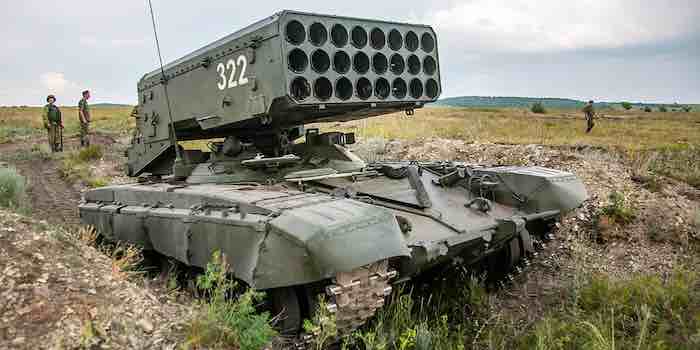
By William Walter Kay BA JD —— Bio and Archives April 14, 2023
Comments | Print This | Subscribe | Email Us

Fourteen months into the Russo-Ukrainian War, Russia remains intriguingly parsimonious in deploying its world-class heavy artillery. This might change. On April 3 Russian media made much ado of a ceremony celebrating the transfer of TOS-1As to Airborne Forces. Hitherto TOS-1As were exclusively in the Radiological-Biological-Chemical Forces’ toolkit. Days later a TOS-1A struck Bakhmut.
“Toss-One-Alpha” to NATO, “Sunshine” to Russians, the TOS-1A is an armoured, self-propelled, ground-assault, multiple-launch-rocket-system firing unusually heavy, unusually short-range, unguided rockets with thermobaric warheads.
Thermobaric explosions have two stages. The first disperses a volatile cloud. The second ignites this cloud. Thermobarics go by misnomers like “flamethrowers” and “vacuum bombs.” Some are called “boiling liquid expanding vapour explosives” (BLEVE). Most are best described as “fuel-air explosives” (FAE) with “metal augmented charges” (MAC), as in the USAF’s MAC-Hellfire missile. Russians prefer: “metallized volumetric explosives.”
Thermobaric warheads contain a mix of fuel and powdered aluminum (or manganese). In the milliseconds between the cloud’s emission and ignition, metal particles capture oxygen. More O2, bigger bang. Much of the mass in thermobaric combustion comes from ambient oxygen grabbed by the metal-laced fuel-cloud. Oxidizers no longer need be added to bomb-fuel. (Gunpowder is 75% oxidizer.) Pound-for-pound, thermobarics are several times more energetic than TNT. Other compounds are equally explosive, however the voluminous, slow-motion thermobaric blast is itself weaponized.
Americans and Soviets originally envisioned thermobarics as blast-wave weapons. The USAF’s 340 kg CBU-55 bomb was designed to use overpressure to detonate landmines. The CBU-55 did not trip landmines as hoped, however a 1975 test yielded a 16,000 square meter kill-zone. (NFL football fields, endzones included, cover 5,300 sq. m.) The USAF stockpiles 910 kg BLU-96-FAEs.
A frontline weapon much like a tank, the original TOS attacked line-of-sight targets under 1,000 meters away. Rockets flew thermobaric warheads directly over enemy fox-holes or trenches. Explosions hammered dug-in infantry with 700 meter-per-second blast-waves.
Modern shoulder-fired anti-armour missiles keep TOS-1As away from frontlines. Now, they lob rockets like conventional artillery launchers, albeit to a max of 10 k. For modern artillery, that’s short-range.
TOS-1A rockets are 22 centimeters in diameter, 3.7 meters long, and weigh 217 kg. As with all heavy artillery TOS-1As require support vehicles, notably a reloading rig with a custom crane.
TOS-1As are 24-barrel tube-launchers atop T-72A tank chasses. TOS-1As zip along at 60 kph for 550 k without refueling. They climb 60% gradients and caterpillar over 1.1 meter vertical obstacles. They aim and fire within 90 seconds of stopping, and launch all 24 rockets in 12 seconds. With proper dispersal a full barrage’s kill-zone spans a dozen football fields.
Accompanying the blast-wave is a lethal 3,000-Celsius fireball. As well, soldiers in bunkers and armoured vehicles have survived explosions only to suffocate in oxygen-deficient air pockets left by thermobaric combustion – hence “vacuum bomb.” The blast-waves don’t merely perforate eardrums; they blow inner ear organs out of soldiers’ heads.
Ukraine’s frontline is defenseless against TOS-1As. Timelapses between launch and detonation are under 30 seconds. Rockets are not interceptable. Biting the dirt in a well-dug trench offers protection from conventional artillery strikes, but not from TOS-1A barrages.
TOS-1A’s forerunner debuted in Afghanistan in 1988 and saw further service in Chechnya and Nagumo-Karabakh. TOS-1As put on a distinguished performance in Syria, 2015. As per the present conflict, prior to the Second Russian Offensive (February 2023), TOS-1As made cameo appearances, notably in the August 2022 scramble for the Metro Donetsk village-suburb of Pesky.
During the Second Russian Offensive, but pre-April 3, Russian Defense Ministry daily reports mentioned “heavy flamethrower” assaults 9 times; always conducted by the obscure “Tsentr Group” and always well north of the Offensive’s main (Donetsk) theatre. They grew from one-off strikes to 6 assaults a day.
NATO propagandists wedge “war crime” or “weapon of mass destruction” into reportage about TOS-1As; but TOS-1A warheads are not qualitatively distinct from regular high explosive or incendiary ordnance.
Like all heavy artillery, TOS-1As are weapons of mass production. Russia advertises their success in destroying fortified targets and armoured vehicles. They’ve sold TOS-1As, or its forerunner, to 8 countries. Their main production facility is the legendary Omsktransmash plant (a Rostec subsidiary). How many operational TOS-1As Russia possesses is classified, but the fleet probably approaches 100 units with more rolling off the Omsk line. NATO produces no counterpart.
Russia manufactures other state-of-the-art heavy artillery systems like the 2S7-Malka and Uragan-1M. These too, mostly wait in the wings. Why? While there are, no doubt, basic production/servicing issues; the Russians appear to be: training crews, working out the bugs, adapting to this battlefield, ramping-up munitions output; and, …keeping their powder dry for climactic conflagrations yet to come.
Second Russian Offensive exertions to capture cities and towns around Metro Donetsk are prelims. The main card includes a heavy artillery cataclysm over Kramatorsk.
They say generals plan to fight their last war again thus the next war dumbfounds them. NATO poohpoohed heavy artillery. Lugging such behemoths around the globe presents additional challenges. As well, US anti-artillery rockets have ranges allowing Ukrainians to hit Moscow, and NATO fears the Ukrainians will do just that. NATO’s naked unpreparedness shows what a long walk off a short pier Biden’s War is shaping up to be.
William Walter Kay, Ecofascism.com